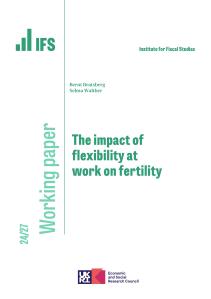£17 billion is gifted or loaned informally each year, almost all from parents to their adult children. This mostly helps with buying a house or is gifted at the point of marriage. These transfers are very unequally spread.
Most transfers come from parents aged over 50 to children in their late 20s and early 30s. Around 30% of young adults receive at least one substantial transfer (of £500 or more) over any eight-year period.
Unsurprisingly these gifts increase inequality among the younger generation. The children of university-educated homeowning parents receive around six times more in wealth transfers during their 20s and early 30s than the children of renters. White young adults are three times more likely to receive a substantial gift than Pakistani or Bangladeshi young adults.
These are among results from new IFS research, funded by the IFS Retirement Savings Consortium and the Economic and Social Research Council and published today.
Other key findings include:
Wealth transfers widen inequalities in young adults’ economic resources.
- Over an eight-year period in early adulthood, those in the highest-income fifth of young adults are over three times more likely to receive a transfer than those in the lowest-income fifth. The amounts received by the highest-income fifth are 26 times bigger than those received by the lowest-income fifth.
- The highest-income fifth receive an average of £6,300, or 3% of their income over the same period, while the lowest-income fifth receive an average of £240, or 0.5% of their income over the same period.
Young people with wealthier, homeowning parents tend to have higher incomes than others. They also get more and bigger gifts from their parents.
- Over half of the value of transfers is given by the wealthiest fifth of adults – almost exclusively homeowners and disproportionately living in London and the South East.
- 18% of the children of renters receive a substantial gift in early adulthood, while almost half (46%) of the children of university-educated homeowners receive one in the same period.
Transfers are strongly connected to home purchase and marriage, but less to adverse events in the lives of receivers.
- Half of the value of gifts received is reported as used for property purchase or improvement. Those using transfers for this purpose received over £20,000, on average.
- People are also particularly likely to receive a large gift when they get married, but are not more likely to receive transfers when facing adverse events such as losing their job.
- Those in the least-wealthy third are relatively more likely to report using gifts for the purchase of a new car, to pay off debts or for educational expenses.
White young adults receive substantial gifts much more often than black or Asian young adults.
- 1 in 10 white young adults receive a gift in a two-year period, compared with 1 in 25 black African or black Caribbean young adults, and less than 1 in 30 Pakistani or Bangladeshi young adults. Differences in parents’ wealth between these groups is likely a key driver.
Women are more likely to receive gifts in early adulthood and much more likely to give gifts and loans following the death of a spouse.
- Even when we account for the differences in their income, wealth level and other characteristics, women are more likely than men to receive gifts at younger ages, while men are more likely to give gifts at older ages.
- Women often make gifts and loans when they become widowed, while men are not any more likely to give when they lose a partner.
Bee Boileau, a Research Economist and author of the report, said:
‘Substantial intergenerational transfers happen when people – particularly those with richer parents – are in early adulthood and are buying their first home or getting married. While these transfers are important assistance for some, they are very unequally spread. The children of university-educated homeowning parents receive around six times more in wealth transfers during their 20s and early 30s than the children of renters, while white young adults are three times more likely to receive a substantial gift than Pakistani or Bangladeshi young adults. As well as the benefits these transfers can provide, policymakers should therefore keep in mind these transfers’ potential to pass on inequalities from one generation to the next.’








